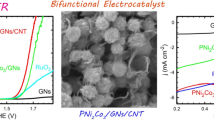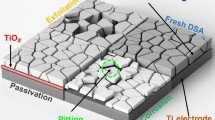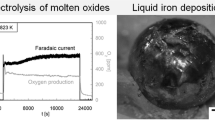The composition of oxide nanofilm formed on the HfC anode under electrolysis of a 3% NaCl solution at potentials between – 0.20 and +1.90 V is studied using the potentiodynamic method of polarization curves and Auger electron spectroscopy and SEM methods. The film consists of the upper layer formed in polymolecular chemosorption of O2 and Cl2 gases followed by the HfO2 + C (1 : 1) layer. Two inner layers represent a 7 at.% O2 solid solution in HfC and a mixture of HfC0.7O0.3 and HfO (7 : 1). The oxide film 30–40 nm thick formed at potentials up to 1.35 V is protective and ensures very high corrosion resistance of HfC without any further polarization.
Similar content being viewed by others
References
V. A. Zhilyaev, Yu. G. Zainulin, S. I. Alyamovskii, and G. P. Shveikin, “High-temperature oxidation of zirconium and hafnium oxycarbides and oxycarbonitrides,” Powder Metall. Met. Ceram., 11, No. 8, 632–636 (1972).
R. F. Voitovich and E. A. Pugach, “High-temperature oxidation of ZrC and HfC,” Powder Metal. Metal Ceram., 12, No. 11, 916–921 (1973).
B. Bargeron, C. B. Benson, R. C. Newman, and W. Robby, “Oxidation mechanisms of hafnium carbide and hafnium diboride in the temperature range 1400–2100°C,” John Hopkins APL Technical Digest, 14, No. 1, 29–36 (1993).
B. Bargeron, C. B. Benson, A. N. Jette, and T. E. Phillips, “Oxidation of hafnium carbide in the temperature range 1400–2060°C,” J. Am. Ceram. Soc., 76, No. 4, 1040–1046 (1993).
P. Sourdiaucourt, A. Derre, P. Delhaes, and P. David, “Mechanical reinforcement of carbon foam by hafnium carbide deposit,” J. Phys. IV France, 9, 1187–1194 (1999).
Non-consumable Electrode for Plasma-Arc Welding, US Patent 4304984.
S. Shimada, F. Janazar, and S. Otani, “Oxidation of HfC and TiC single crystals with formation of carbon at high temperatures and low oxygen pressures,” J. Am. Ceram. Soc., 83, No. 4, 722–728 (2000).
S. Shimada, “Thermoanalytical study on the oxidation of ZrC and HfC powders with formation of carbon,” Solid State Ionics, 149, No. 3–4, 319–326 (2002).
K. Edamoto, Y. Shiroton, T. Sato, and K. Ozama, “Photoemission spectroscopy study of the oxidation of HfC (100),” Appl. Surf. Sci., 244, No. 1–4, 174–177 (2005).
S. Shimada, “Formation of oxide layer on HfC (100) surface studied by photoemission spectroscopy,” J. Surf. Sci. Nanotechn., 4, 219–226 (2006).
N. A. Izgaryshev and S. V. Gorbachev, Course of Theoretical Electrochemistry [in Russian], Gostekhizdat, Moscow (1951), p. 503.
V. A. Lavrenko, V. N. Talash, M. Desmaison-Brut, et al., “Kinetics and mechanism of the electrochemical oxidation of hafnium boride,” Powder Metall. Met. Ceram., 48, No. 7–8, 462–465 (2009)
Author information
Authors and Affiliations
Corresponding author
Additional information
Translated from Poroshkovaya Metallurgiya, Vol. 48, No. 9–10 (469), pp. 133–139, 2009.
Rights and permissions
About this article
Cite this article
Lavrenko, V.A., Talash, V.N., Desmaison-Brut, M. et al. Protective oxide layers formed during electrochemical oxidation of hafnium carbide. Powder Metall Met Ceram 48, 595–599 (2009). https://doi.org/10.1007/s11106-010-9173-0
Received:
Published:
Issue Date:
DOI: https://doi.org/10.1007/s11106-010-9173-0




